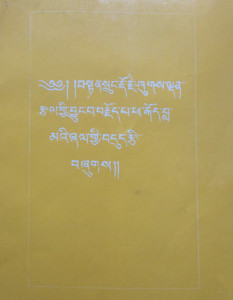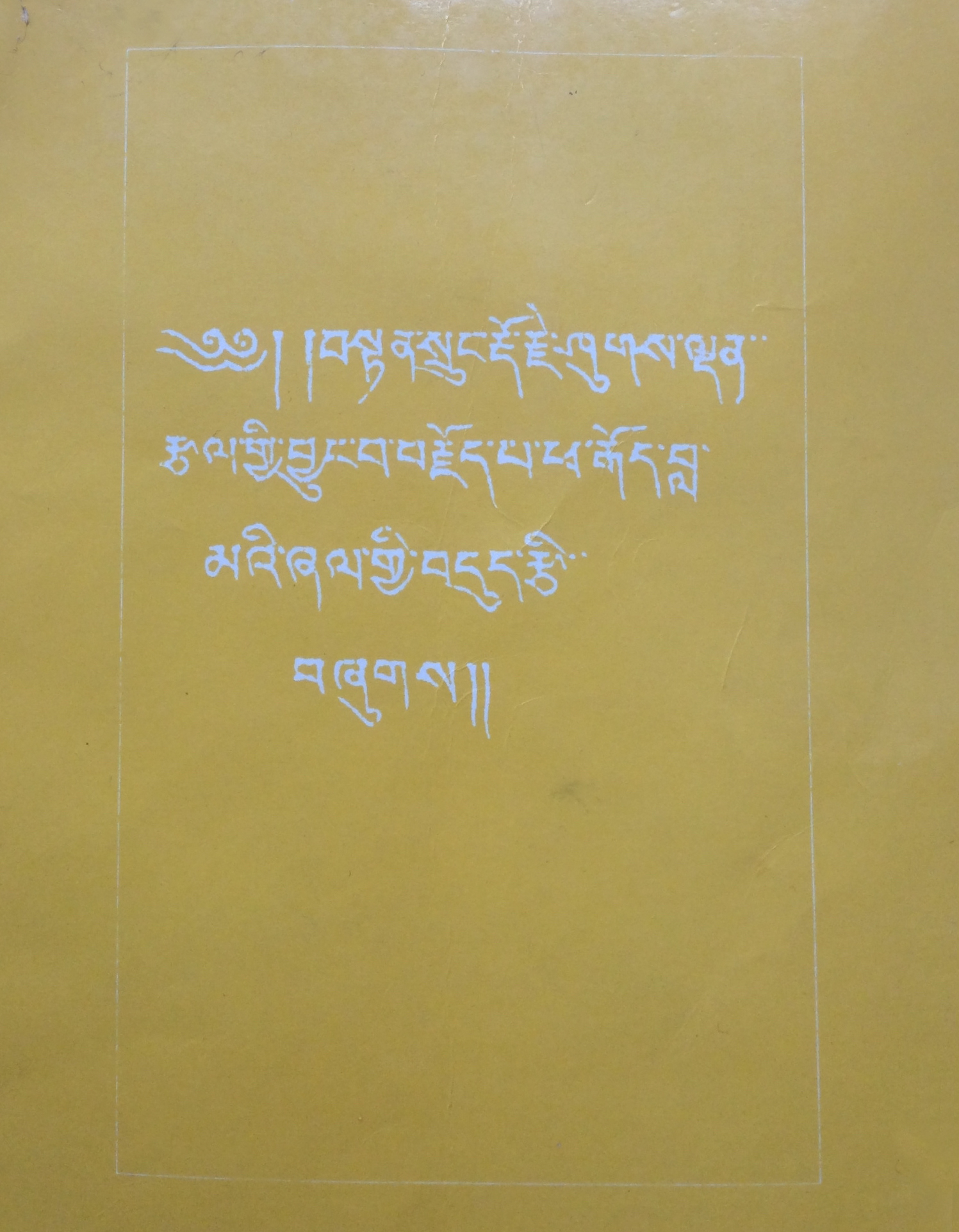[An excerpt from His Holiness’ speech on 13th June, 1978] Nechung once gave a prophecy that conducting a feast offering ritual in connection with Guru Padmasambhava at Tsuglak Khang [the main temple in Dharmsala where His Holiness usually conducts his teachings and other religious activities] would bring about some positive signs concerning the general welfare of Tibet. In the beginning, as we were not well versed in the rituals of the Nyingma tradition to conduct the Great Feast Offering Ritual of Guru Padmasambhava, and as I did not have The Sealed Secrecy [the 5th Dalai Lama’s works on Nyingma teachings] in my possession at that time, we had to search for a suitable ritual text. As Thuwuken’s writing on the Secretly Accomplished Haryangriva, present within the ‘TA’ volume of his work, consists of a feast offering ritual to Guru Padmasambhava — usually conducted on the tenth day of a month [in accordance with the traditional Tibetan lunar calendar] — along with instructions on the purpose as well as the manner of conducting the offering, and as it was quite impressive, we adopted it. Although Thuwuken compiled them together, the works are actually those of the second Dalai Lama, Gyalwa Gendun Gyatso, and Panchen Lobsang Choeki Gyaltsen [the 1st Panchen Lama]. Since then, for some time we had used the same ritual-text at Tsuglak Khang when conducting feast offering rituals to Guru Padmasambhava.

Then after some years, in 1975, on the 10th day of the 1st month of the Wooden Rabbit Year, the day that marked the Treldha Tsecho Ceremony, it so happened that several Geluk monks and nuns became reluctant to attend the feast-offering ritual to Guru Padmasambhava held at Tsuglak Khang, with some of them avoiding the prayer gathering. All Tibetans are supposedly aspiring for freedom; the construction of an image of Guru Padmasambhava at the Tsuglak Khang temple was not for the personal well-being of me, Tenzin Gyatso: Guru Padmasambhava is the common Lama for all Tibetans, with special aspirations and commitments at this time of decadence when human and non-human negativities are at their peak, and with whom we Tibetans have special karmic and positive connections. As such, to beseech him with fervent supplications is important for all of us Tibetans. When this incident occurred on an important occasion such as this which concerns the well-being of the entirety of Tibet as a nation, I felt quite bad about it. When I made enquiries about it, people told me that a terrifying book is out there in print, and for fear of retribution, the nuns [and others] did not attend the gathering. Later, I got hold of the yellow book titled The Nectar from the Mouth of My Heroic Father, written by Zemey Rinpoche.
Zemey Rinpoche had kept me in the darkness; I got to know about the book only when I made enquiries since I wanted to know why people were reluctant to attend the feast-offering ritual. When I learned about the yellow book, it was already out in print and publicised. Later, after one or two days, I received the first copy of a handwritten book of Dongthok Tenpai Gyaltsen [a Sakya Lama] which refutes Zemey’s claims in the latter’s yellow book. Thus, I got hold of the yellow book as well as its rebuttable. At that time, I was truly saddened by the [unforeseen] development. Whatever my personal practices in my room might be, when I go to the office, I always go there as a person committed to the welfare of the whole of Tibet. I was never biased towards any particular tradition, be it Geluk, Nyingma, Sakya, Kagyu or any other tradition. Considerations such as my origin from Amdo or any other divisive thoughts were never factors for me to deviate from my commitments as a representative of all; I was never biased toward one, or disinclined against another, and have always maintained my sense of being everyone’s representative. Such a stance invited varied responses from others, but that was inevitable as certain things appreciated by some would not go well with those on the other side. For example, some from the Geluk tradition insinuated that I was not taking care of them; such complains also came from the Nyingma as well as from the Kagyu and other schools. Other than viewing them as signs of my being a common representative of all, I had no other misgivings about them.
At a time when I was doing my best, shouldering on my responsibilities for the well-being of all, although it is quite natural for someone who had past grudges to embitter him, or another who did not know facts well to create a chaotic situation, and in such a case I would have seen their action as excusable, Zemey Rinpoche fit into neither of these two categories. For one, he was very much familiar with my religious policy and attitude towards all traditions. When the ‘teachers’ training program’ was held at Kangra due to our inability to arrange accommodations in lower Dharamsala, I purposely paid them a visit. In their spacious room, with myself at the centre flanked by Kundeling Rinpoche on one side and Zemey Rinpoche on the other, I delivered a long speech to the participants of the program. In that speech, I reasoned that if we were to consider the Geluk’s view as the only correct one and the rest as erroneous, and if this were true, then we would have to accept that before Tsongkhapa’s period, let alone enlightenment within one life span, nobody in Tibet could have ever actualised any path beyond the Middling Path of Accumulation. However, the fact stands that before Tsongkhapa’s period, there were many who had accomplished the Great Union. All of those great masters had definitely realised the accurate view since without the accurate view [of emptiness], no one could ascend the path beyond the Middling Path of Accumulation. When I explained that very explicitly, Zemey Rinpoche was right there beside me and heard everything; there was no probability that he couldn’t have heard that: There was no room for his ignorance in this regard.
Also, when I went to China, due to Kyabje Trijang Rinpoche’s closeness to him, I took him with me. In 1956, when I was invited to India for the Buddha Jayanti celebration, again I took him with me. Following our escape to India after 1959, as we conducted the ‘teachers’ training program’, I appointed him the director of the program. Thus, he was somebody I had treated with special kindness. Someone like him who was not ignorant and knew things well, and to whom I had been exceptionally kind throughout, behaved very ungratefully. Even if he couldn’t have helped me in sharing the burden or given me a helping hand, it was totally unexpected of him to derail the hard works I have been tasked with for the general well-being of Tibet. Thus, by all means, even if his action was not an intentional disparagement, it was, with one hundred percent certainty, a derisory one, making a mockery of my policy; even a blind could figure this out. Therefore, I was greatly saddened.
How would others look at this? Someone who has been treated with special kindness and put to tasks by the Dalai Lama has written such a book! He claims them to be the words of Trijang Rinpoche, one of the Dalai Lama’s tutors. Thus, anyone who could speculate may think thus: “Oh, so the only difference is of being outspoken about it or not; or of being overt or not; and yet, now the fact remains clear that they all share the same spirit of sectarianism. As one of the Dalai Lama’s tutors is quoted as saying thus and as this is written by someone on whom the Dalai Lama has shown special kindness, although outwardly the Dalai Lama so convincingly claims his policy to be unbiased and non-sectarian, in truth, his deeply ingrained attitude is similar to this!’. Although this is something that Kyabje Trijang Rinpoche should have considered and the same applies to Zemey Rinpoche, such a thought did not occur to either of them.
From another perspective, it is highly questionable how many of the claims in Zemey’s yellow book could be validated or taken literally. Ultimately, other than saying ‘oh it just occurred to me’, I doubt if there is anything more to it. Even if such claims could actually be proven, whether to consider them commendable or despicable needs to seen. How does it look if the greatness of Tsongkhapa’s doctrine needs to be expressed in terms of the wraths of a controversial protector? Even if those [wraths] are great and worthy of admiration, there is more risks than benefits by spelling out such [divisive] words [in the society]; what benefit is there in that?
Basically, the main point of emphasis in there [the yellow book] relates to ‘the exploitation of the purity of Tsongkhapa’s doctrine’. If practising other traditions amounts to exploiting the purity of Tsongkhapa’s doctrine, who could have corrupted the purity of Tsongkhapa’s doctrine more than all the past Dalai Lamas in general, and particularly the 2nd, the 3rd, and above all the 5th Dalai Lama? However, the fifth Dalai Lama wrote thus:
‘By abiding in pure discipline, with extensive hearing,
Practising Bodhichitta and maintaining pure deeds and views,
To the doctrine of the second Buddha Lobsang [Dakpa],
May I make contributions without exploiting it.’
In that case, would this not be a big lie on his part? Such a bikshu [a fully ordained monk] scholar of his calibre would not speak such an insensible, and yet, easily detectable lie. In Khedrup Gelek Pelsang’s [one of the principle students of Tsongkhapa] work called A Commentary on the View Called the Lamp that Illuminates Darkness, he speaks on the meaning of exploitation as he explains the view of The Indivisibility of Samsara and Nirvana in accordance with the tradition of Sakya. In it, he says that we should not try to apply the Sakya’s terminological understanding onto Tsongkhapa’s instructions on ‘how to apply view into meditative practice’, and distort the unique terminological interpretations of each system by one’s own misleading mental projections. Hence, Khedrup Rinpoche reiterates that unique terminological interpretations of other traditions should not be used to unlock technical concepts of the Geluk tradition and vice-versa, as doing so would only corrupt the original purity of each of these instructions. So, refraining from exploiting the purity of a tradition, according to Khedrup Je, does not mean that a Geluk practitioner should refrain from practising other traditions such as Nyingma; neither does it mean that Nyingma practitioners should avoid practising the Geluk teachings. If it was wrong for a Geluk practitioner to practise Nyingma teachings and for a Nyingma devout to practise Geluk teachings, then starting from Gyaltsab Je and Khedrup Je [the two most prominent disciples of Tsongkhapa], many of the Geluk Geshes should be held accountable for religious exploitation. Some Geluk followers seem to think that practising any of the Nyingma teachings is wrong, and yet they seem to rejoice if a Nyingma practitioner hears a Lamrim teaching. Using unique Geluk terminologies and practices to corrupt the original form of Nyingma teachings also contradicts with Khedrup Je’s instructions. According to them [exclusivists], it appears that we have to treat one another as if we belonged to traditions that alienate one another.
Holding a non-sectarian approach to different traditions or forms of practices does not amount to exploiting or corrupting any of the traditions; here, not exploiting only means that we should not muddle up the unique characteristics of different traditions. Therefore, in the 5th Dalai Lama’s Lamrim text Words from the Mouth of Manjugosha, you do not find any terms specific to the Nyingma tradition; neither would you find any terms specific to the Geluk tradition in his commentary on the Zogchen [the Great Perfection/Completion] View called Words from the Mouth of the One Who holds the Awareness. Both of these two texts did not mix up different philosophical terms, but remained true to the unique traditions they represent. Thus, in my understanding, holding on to their own unique terminologies without muddling them up is the genuine interpretation of Khedrup Rinpoche’s intent on being free of exploitation [or maintaining the purity of each tradition].
In Maitreya’s Ornament of Clear Realisation it says thus:
“Those aspiring to benefit wandering beings accomplish the welfare of universally vast number of beings by means of their realisations of [different] paths.”
As such, for someone aspiring to practise Mahayanan paths, he has to hear, contemplate and meditate on different levels of tenets as well as different kinds of vehicles [lower and upper]. Likewise, there is nothing wrong for anyone in trying to understand and practice different religious traditions within Tibetan Buddhism, such as Sakya, Kagyu, etc, that would suit their mental inclination; on the contrary, it is worthy of every appreciation. When that yellow book came into being, Dongthog Rinpoche wrote a refutation to challenge it. I also heard that, unable to tolerate it, some from the Tibetan Institute at Varanasi decided to write a response. It was also rumoured and speculated among Geluk followers that although Dongthog’s book carried his name, in truth it was Dudjom Rinpoche’s writing, and Dongthog only lent his name to the book. How does this sound? Although it would not matter to me if Zemey Rinpoche and Dongthog Rinpoche had debates in their own individual capacities, Zemey claims in his book that those [stories] written there were instructions of Kyabje Trijang Rinpoche, a prominent Geluk Lama, while the book of Dongthog was rumoured to be written by Dudjom Rinpoche [a prominent Nyingma Lama].
As the unfolding event could lead to disastrous disputes between two important Tibetan Buddhist traditions, the matter was a highly sensitive one. Taking action instantly, I asked the Religious Department of our Administration to issue a formal notice of caution to both sides, stating that the root of the crisis is Zemey’s yellow book, and that everyone should think for the greater good of Buddhism; thus, all should restrain from any activity that would create chaos. Since that notice was issued, there was no retaliatory response from the Geluk side; Nyingmas too, although they seemed to have done some preparations earlier, respected the notice from the Religious Department and did not write any refutation.



